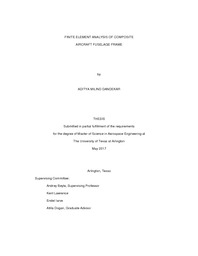
ATTENTION: The works hosted here are being migrated to a new repository that will consolidate resources, improve discoverability, and better show UTA's research impact on the global community. We will update authors as the migration progresses. Please see MavMatrix for more information.
Show simple item record
| dc.contributor.advisor | Beyle, Andrey | |
| dc.contributor.advisor | Dogan, Atilla | |
| dc.creator | Dandekar, Aditya Milind | |
| dc.date.accessioned | 2017-07-03T15:54:51Z | |
| dc.date.available | 2017-07-03T15:54:51Z | |
| dc.date.created | 2017-05 | |
| dc.date.issued | 2017-05-15 | |
| dc.date.submitted | May 2017 | |
| dc.identifier.uri | http://hdl.handle.net/10106/26833 | |
| dc.description.abstract | Composites have been introduced in aircraft industries, for their stronger, stiffer, and lighter properties than their metal-alloys counterparts. The general purpose of an aircraft is to transport commercial or military payload. Aircraft frames primarily maintains the shape of fuselage and prevent instability of the structure. Fuselage is similar as wing in construction which consist of longitudinal elements (longerons and stringers), transverse elements (frames and bulkheads) and its external skin. The fuselage is subjected to forces such as the wing reactions, landing gear reaction, empennage reaction, inertia forces subjected due to size and weight, internal pressure forces due to high altitude. Frames also ensure fail-safe design against skin crack propagation due to hoops stress. Ideal fuselage frames cross section is often circular ring shape with a frame cap of Z section. They are mainly made up of light alloy commonly used is aluminium alloys such as Al-2024, Al-7010, Al-7050, Al-7175. Aluminium alloys have good strength to density ratios in compression and bending of thin plate. A high strength to weight ratio of composite materials can result in a lighter aircraft structure or better safety factor. This research focuses on analysis of fuselage frame under dynamic load condition with change in material. Composites like carbon fibre reinforced plastics [CFRP] and glass fibre reinforced plastics [GFRP] are compared with traditional aluminium alloy Al-7075. The frame is subjected to impact test by dropping it at a velocity of 30 ft. / secs from a height of 86 inch from its centre of gravity. These parameters are considered in event of failure of landing gear, and an aircraft is subject to belly landing or gear-up landing. The shear flow is calculated due to impact force which acts in radial direction. The frame is analysed under static structural and explicit dynamic load conditions. Geometry is created in ANSYS Design Modeler. Analysis setup is created using ANSYS Explicit Dynamic (AUTODYN) and ANSYS Composite PrepPost (ACP-Pre) modules. Shear flow and Stress Flow equations are solved by generating a MATLAB code. | |
| dc.format.mimetype | application/pdf | |
| dc.language.iso | en_US | |
| dc.subject | Composites | |
| dc.subject | GFRP | |
| dc.subject | CFRP | |
| dc.subject | Fuselage frames | |
| dc.subject | Dynamic analysis | |
| dc.subject | Drop test | |
| dc.subject | ANSYS composite prep-post | |
| dc.subject | ANSYS explicit dynamics | |
| dc.subject | AUTODYN | |
| dc.subject | Shear flow | |
| dc.title | FINITE ELEMENT ANALYSIS OF COMPOSITE AIRCRAFT FUSELAGE FRAME | |
| dc.type | Thesis | |
| dc.degree.department | Mechanical and Aerospace Engineering | |
| dc.degree.name | Master of Science in Aerospace Engineering | |
| dc.date.updated | 2017-07-03T15:55:54Z | |
| thesis.degree.department | Mechanical and Aerospace Engineering | |
| thesis.degree.grantor | The University of Texas at Arlington | |
| thesis.degree.level | Masters | |
| thesis.degree.name | Master of Science in Aerospace Engineering | |
| dc.type.material | text | |
Files in this item
- Name:
- DANDEKAR-THESIS-2017.pdf
- Size:
- 2.325Mb
- Format:
- PDF
This item appears in the following Collection(s)
Show simple item record


